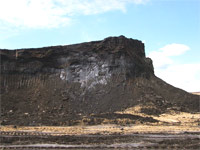
News |
- Oilsands Need Water Rules
- Grizzly Bears in Manitoba
- Carbon Capture No Silver Bullet - WWF Letter
- Ontario Unveils Green Energy Act
- Nations To Negotiate Mercury Treaty
- New BioGem Announced for Alberta
- Energy Efficiency Cuts Consumption 30%
- Earth Days - Environmental Movement Film
- Principles to Guide Climate Change Legislation
- Sign Up For Earth Hour 2009
- Canada Fails to Report Toxic Mine Tailings
- Covenant of Mayors Push Energy Efficiency
| Oilsands Need Water Rules | 06 March 09 |
 Pembina Institute, an environmental think-tank and a group of Aboriginal leaders are calling on the Alberta government to stop oilsands development near Fort McMurray until a transboundary water agreement with the Northwest Territories (NWY) is in place. Pembina Institute, an environmental think-tank and a group of Aboriginal leaders are calling on the Alberta government to stop oilsands development near Fort McMurray until a transboundary water agreement with the Northwest Territories (NWY) is in place.A legally binding transboundary water agreement is among six recommendations for improving oilsands water management and minimizing risks to water resources in the report Pembina Institute report, The Waters That Bind Us: Transboundary Implications of Oil Sands Development. Oilsands development poses huge risks to both local and downstream water resources. Leaders of the Dene Nation say there should be more northern involvement in oilsands-related discussions and planning. They are urging the NWT Association of Communities to call on the Alberta government to create emergency plans should toxic oilsands tailings break. The NWT government is working on its own water strategy since negotiations between Alberta and the Northwest Territories were suspended 18 months ago. View Pembina Institute report, The Waters That Bind Us: Transboundary Implications of Oil Sands Development (PDF)View February 24, 2009 CBC article View February 25, 2009 Fort McMurray Today article View February 24, 2009 Slave River Journal article Sources: The Pembina Institute, CBC, Fort McMurray Today, Slave River Journal |
|
 Print version Print version |
Top |
| Grizzly Bears in Manitoba | 05 March 09 |
 Grizzly bears, officially considered extinct in Manitoba, have recently been sighted near Hudson Bay in the province. Sightings have been linked to changing climate and habitat. The provincial government quickly added grizzly bears to the list of species protected from hunting under The Wildlife Act. Grizzly bears, officially considered extinct in Manitoba, have recently been sighted near Hudson Bay in the province. Sightings have been linked to changing climate and habitat. The provincial government quickly added grizzly bears to the list of species protected from hunting under The Wildlife Act. Provincial biologist Bill Watkins told the Winnipeg Free Press that Manitoba Conservation confirms one to three grizzly-bear sightings every year. Officials say it does not appear grizzlies are breeding inside the province but believe the bears are coming down from Nunavut to look for food. The historic range of the grizzly bear once reached as far southeast as Winnipeg. Wildlife biologists say the bears need protection against hunters to encourage them to reoccupy Manitoba. Gaile Whelan Enns, director of Manitoba Wildlands, said governments around the world will have to adapt as climate change drives species from their usual habitats. "Grizzly bears are probably being pushed southward because of changes in permafrost and the growing unpredictability of winter, food supplies, and possible hibernation changes. These bears are like a climate change canary in the mine shaft," she said. View March 2, 2009 Globe and Mail articleView January 26, 2009 Winnipeg Free Press article View March 2, 2009 Canadian Press article View Hinterland Who's Who on the Grizzly Bear View The Animal House Grizzly Bear videos Sources: Globe and Mail, Winnipeg Free Press, Canadian Press, Manitoba Wildlands |
|
 Print version Print version |
Top |
| Carbon Capture No Silver Bullet - WWF Letter | 05 March 09 |
 WWF prides itself on being a science-based organization. Gerald Butts, president of WWF Canada, and Carter Roberts, president of WWF-US, have written to President Barack Obama to say carbon storage is a welcome but limited weapon in the fight against climate change. The WWF Canada president also had a letter published in the Toronto Star. WWF prides itself on being a science-based organization. Gerald Butts, president of WWF Canada, and Carter Roberts, president of WWF-US, have written to President Barack Obama to say carbon storage is a welcome but limited weapon in the fight against climate change. The WWF Canada president also had a letter published in the Toronto Star.'The governments of Canada and Alberta know this (that carbon storage is a limited weapon against climate change). Their task force on the subject told them as much just a year ago: "Oil-sands operations are very diverse (both geographically and technically) and only a small portion of the carbon dioxide streams are currently amenable for carbon capture and storage."' 'The argument from tar-sands defenders in both the Canadian Conservative and Liberal ranks can be fairly summarized as follows: "We know this is bad for us but we have faith that a technological fix called carbon capture and storage will make everything better."' 'Canadians deserve a more honest debate about tar-sands development. If the leaders of our two major national parties cling to the outdated notion that we need to endure environmental devastation to grow the economy, then let them say so.' View February 27, 2009 Toronto Star Opinion letterVisit WWF Canada website Source: Toronto Star |
|
 Print version Print version |
Top |
| Ontario Unveils Green Energy Act | 04 March 09 |
 Ontario's ambitious Green Energy and Green Economy Act was unveiled last week by Premier Dalton McGuinty and Energy Minister George Smitherman. The Act lays the foundation for energy conservation and expansion of renewable energy in the province. Ontario's ambitious Green Energy and Green Economy Act was unveiled last week by Premier Dalton McGuinty and Energy Minister George Smitherman. The Act lays the foundation for energy conservation and expansion of renewable energy in the province. The Act also includes measures to foster a new green economy by giving organizations and local communities opportunities to develop renewable energy generation projects. An estimated 50,000 jobs are expected to be created within three years. "This Act puts in place the framework for green energy to thrive and could set us on a path toward a future based on the efficient use of renewable energy," said Keith Stewart, Climate Change Campaign Manager, WWF-Canada. The Act would enact standards for renewable energy projects and provide incentives for homeowners to develop on-site energy generation, like small turbines. The Act also focuses on energy conservation planning at the local level, energy audits, building codes, and upgrading government buildings to new energy efficiency standards. View Bill 150, Ontario Green Energy and Green Economy Act, 2009 (PDF)View Ontario's Proposed Green Energy Act, Our Path to a Green Economy and Cleaner Environment View February 23, 2009 Green Energy Act press release View February 25, 2009 Renewable Energy article View February 25, 2009 New York Times article View February 23, 2009 MSNBC article View February 24, 2009 WWF Canada release Sources: Green Energy Act, Ontario Ministry of the Environment, Renewable Energy World, New York Times, MSNBC |
|
 Print version Print version |
Top |
| Nations To Negotiate Mercury Treaty | 26 February 09 |
 Governments of more than 140 nations have agreed to negotiate an international treaty to phase out the use of mercury. The decision took place at the United Nations Environmental Programme's (UNEP) Governing Council early February 2009. Governments of more than 140 nations have agreed to negotiate an international treaty to phase out the use of mercury. The decision took place at the United Nations Environmental Programme's (UNEP) Governing Council early February 2009. Mercury is a toxic heavy metal known to damage the human nervous system. Nearly 6,000 tons of mercury are released into the environment every year, a third is caused by burning coal. In an encouraging move the United States government reversed its policy on mandatory mercury emissions reductions and consented to treaty negotiations that will begin later in 2009 to conclude by 2013. A voluntary international Global Mercury Partnership will be in place until the treaty is finalized. The Partnership will reduce mercury in industrial products and processes, cut emission to the atmosphere and clean up contaminated sites. View February 20, 2009 UNEP press release (PDF)View February 20, 2009 Reuters article View February 24, 2009 GreenBiz article View February 24, 2009 Nature News article Sources: UNEP, Reuters, GreenBiz, Nature News |
|
 Print version Print version |
Top |
| New BioGem Announced for Alberta | 26 February 09 |
 Each year the Natural Resource Defense Council (NRDC) a Washington based environmental organization, campaigns to save natural regions threatened by development and destruction across the Americas. Selected BioGems are areas of wilderness home to endangered wildlife which contribute to reducing global warming by remaining undeveloped. Each year the Natural Resource Defense Council (NRDC) a Washington based environmental organization, campaigns to save natural regions threatened by development and destruction across the Americas. Selected BioGems are areas of wilderness home to endangered wildlife which contribute to reducing global warming by remaining undeveloped.The NRDC, and a northern Alberta environmental organization named the Peace-Athabasca Delta are working together to save this new BioGem. "The Peace-Athabasca Delta is one of the world's most important nesting grounds for migratory birds. But these rest areas are threatened by the world's largest industrial project - Alberta's tar sand mines," said Susan Casey-Lefkowitz, director of Natural Resources Defense Council's Canada program. Web audiences, and Canadians can sign on to participate in actions to save the Peace-Athabasca Delta. Visit Save BioGems - Peace-Athabasca DeltaView February 3, 2009 Edmonton Journal article View February 3, 2009 Vancouver Sun article View December 3, 2008 Boreal Birds article View NRDC report, Danger in the Nursery: Impact on Birds of Tar Sands Oil Development in Canada's Boreal Forest (PDF) Sources: NRDC, Edmonton Journal, Vancouver Sun |
|
 Print version Print version |
Top |
| Energy Efficiency Cuts Consumption 30% | 24 February 09 |
 A study by the Rocky Mountain Institute assessed the "electric productivity" of the 50 United States and found that energy efficiency could cut consumption by 30 percent and eliminate the need for more than 60 percent of coal-fired generation in the US. A study by the Rocky Mountain Institute assessed the "electric productivity" of the 50 United States and found that energy efficiency could cut consumption by 30 percent and eliminate the need for more than 60 percent of coal-fired generation in the US.Assessing the Electric Productivity Gap and the U.S. Efficiency Opportunity determined the productivity rate of each state by measuring how much gross domestic product is generated for each kilowatt-hour consumed. "Closing the electric productivity gap through energy efficiency is the largest near-term opportunity to immediately reduce electricity use and greenhouse gases, and move the United States forward as a leader in the new clean energy economy," Natalie Mims, a consultant on RMI's Energy and Resources Team, said in a statement. RMI also released an interactive map, which ranks the electric productivity of each of the 50 states and highlights opportunities for states to adopt practices of top-ranked states. View RMI report, Assessing the Electric Productivity Gap and the U.S. Efficiency Opportunity (PDF)View RMI Interactive Report Map View January 30, 2009 RMI press release View February 10, 2008 World Business Council for Sustainable Development release View February 12, 2009 Consulting-Specifying Engineer article Sources: Rocky Mountain Institute, World Business Council for Sustainable Development, Consulting-Specifying Engineer |
|
 Print version Print version |
Top |
| Earth Days - Environmental Movement Film | 24 February 09 |
 Robert Stone's Earth Days, a reflective film about North America awakened to the environmental crisis was honored as the closing night movie at the 2009 Sundance Film Festival held in Utah. Robert Stone's Earth Days, a reflective film about North America awakened to the environmental crisis was honored as the closing night movie at the 2009 Sundance Film Festival held in Utah.Earth Days tells the story of the environmental movement through the lives and contributions of nine pioneering environmentalists. Stone recounts the impact of Rachel Carson's 1962 bestseller "Silent Spring" among others. "So many of the films and books I've seen and read about the environment have been about looking forward; where we'll be in five or 10 years from now," Mr. Stone said. "But it occurred to me that by looking back to where we've come from, what we've learned could be very informative in where we are going and how we move forward." Earth Days will be released in theaters on Earth Day, April 22 and will air on PBS in April 2010 to commemorate the 40th anniversary of Earth Day. View February 14, Common Dreams articleView February 5, 2009 Variety article View January 28, 2009 Reuters article Source: Common Dreams, Variety, Reuters |
|
 Print version Print version |
Top |
| Principles to Guide Climate Change Legislation | 24 February 09 |
 The United States Senate Committee on the Environment and Public Works unveiled a set of "principles" to guide their efforts to draft a cap-and-trade bill to limit greenhouse gas emissions. The United States Senate Committee on the Environment and Public Works unveiled a set of "principles" to guide their efforts to draft a cap-and-trade bill to limit greenhouse gas emissions.The document released by Democratic Senator Barbara Boxer, who chairs the panel, gave no details on emission reduction targets but promises to reduce emissions "to levels guided by science to avoid dangerous global warming" and to set targets that are "certain and enforceable", as well as adjustable. The six broad principles included: setting short and long-term targets; ensure continued efforts to address global warming; establishing transparent and accountable market-based system to reduce carbon emissions to levels guided by science. It also includes investing revenues in clean technologies; assisting communities and businesses in adapting to global warming impacts; and providing incentives and deterrents will ensure a level global playing field. Senator Boxer did not offer a firm timeline but expects the committee would produce the cap and trade legislation before climate change negotiations continue in Copenhagen this December. View January 29, 2009 U.S. Senate Committee on Environment and Public Works press conferenceView EPW Principles for Global Warming Legislation (PDF) View http://latimesblogs.latimes.com/greenspace/2009/02/boxer-sketches.html February 3, 2009 LA Times article View February 5, 2009 Renewable Energy World article View February 4, 2009 Washington Post article Sources: U.S. Senate Committee on Environment and Public Works, LA Times, Renewable Energy World, Washington Post |
|
 Print version Print version |
Top |
| Sign Up For Earth Hour 2009 | 18 February 09 |
 Join the movement for change - turn off your lights for Earth Hour on March 28th between 8:30 and 9:30 p.m. Last year nearly 50 million people in 370 cities and towns around the world joined the effort and sent a strong message to world leaders. WWF Canada leads Earth Hour in Canada. Join the movement for change - turn off your lights for Earth Hour on March 28th between 8:30 and 9:30 p.m. Last year nearly 50 million people in 370 cities and towns around the world joined the effort and sent a strong message to world leaders. WWF Canada leads Earth Hour in Canada."With hundreds more cities expected to sign up to switch off in the coming months, Earth Hour 2009 is setting the platform for an unprecedented global mandate for action on climate change," said James Leape, WWF Director General. Earth Hour is a World Wildlife Fund (WWF) event started in Sydney Australia in 2007. This year the WWF Earth House goal is for one billion people in 1,000 cities worldwide to participate in Earth Hour. Spread the word! This grassroots campaign relies on you to invite your friends, family and local businesses to participate. Sign up at www.EarthHourCanada.org. Campaign images, posters, flyers, emails and videos are available on the website. Visit WWF - Earth HourView March 2, 2009 WWF Canada press release View February 5, 2009 MSN News article View February 5, 2009 Earth Times article View February 12, 2009 Sydney Morning Herald article Sources: WWF, MSNBC, The Earth Times, The Sydney Morning Herald |
|
 Print version Print version |
Top |
| Canada Fails to Report Toxic Mine Tailings | 18 February 09 |
 Canada's Federal Court heard a lawsuit against Minister of the Environment January 2009 for failing to ensure Canada's mining industry publicly reports tailings it generates each year. Ecojustice, on behalf of MiningWatch Canada the Great Lakes United, filed the lawsuit in 2007. Canada's Federal Court heard a lawsuit against Minister of the Environment January 2009 for failing to ensure Canada's mining industry publicly reports tailings it generates each year. Ecojustice, on behalf of MiningWatch Canada the Great Lakes United, filed the lawsuit in 2007.Nearly two million tones of mine tailings are generated each day in Canada. The tailings contain arsenic, mercury, and selenium among other toxins. Until 2006 mining facilities were exempt from reporting pollutant releases and transfers from extraction or primary crushing. The exemption was removed but Ecojustice and the groups allege the minister broke the law when he or ministry employees directed mining companies to not report pollution sent to tailings ponds and waste rock piles to the National Pollutant Release Inventory (NPRI). "We are arguing the minister has ignored his legal duties under the Canadian Environmental Protection Act to provide the public with the full extent of pollutants released by mining companies in Canada," said Justin Duncan, staff lawyer with Ecojustice. View January 19, 2009 Environmental News Service articleView January 19, 2009 MiningWatch Canada article Sources: Environmental News Service, MiningWatch Canada |
|
 Print version Print version |
Top |
| Covenant of Mayors Push Energy Efficiency | 18 February 09 |
 Over 350 cities across Europe have signed the ambitious Covenant of Mayors at the European Parliament in Brussels. Signatory cities are required to reduce carbon dioxide emissions over 20 percent by 2020. Over 350 cities across Europe have signed the ambitious Covenant of Mayors at the European Parliament in Brussels. Signatory cities are required to reduce carbon dioxide emissions over 20 percent by 2020.Participating cities must implement a sustainable energy action plan to promote energy efficiency and cleaner energy production within 12 months. External evaluators monitor the covenant and cities failing to meet obligations will have their membership revoked. "There is a name-and-shame" aspect to the covenant, said Pedro Ballesteros Torres, who is responsible for energy efficiency at the EU Commission. "For a mayor to be told a city is noncompliant would be a very strong thing." Demand for clean energy products has slowed in the current global economic downturn. The European Commission supports the covenant as an incentive for cities to invest in green technologies. Visit Covenant of MayorsView February 12, 2009 Environmental Leader article View February 12, 2009 New York Times Blog article View February 10, 2009 BBC News article Sources: European Commission, Environmental Leader, New York Times, BBC |
|
 Print version Print version |
Top |


 RSS Feeds:
RSS Feeds: